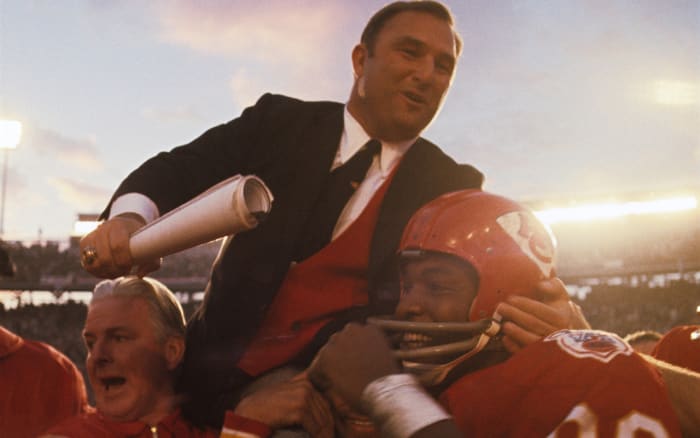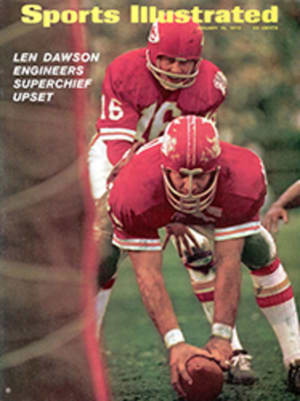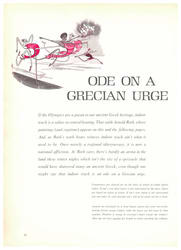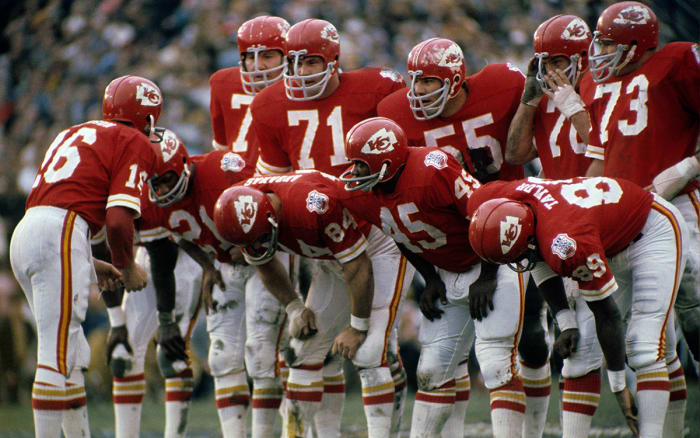Wham, Bam, Stram!
An unlikely-looking little man who favors red vests, checked trousers and infinite variety last Sunday put the art of invention back into football. Hank Stram, coach of the Kansas City Chiefs, threw some of his fanciest formations at the Minnesota Vikings in the Super Bowl and beat them for the championship of the football world by a humbling margin, 23-7.
Of course, Stram did not do this all by himself. His strategy was implemented by what must be recognized now as the finest team in pro football; that is what the winner of the Super Bowl is. The Chiefs' lines—on both offense and defense—gave the Purple People Eaters a world-champion case of indigestion. Len Dawson, who before this game was considered a rather namby-pamby type of quarterback, given to collapsing in a heap before any kind of rush, faced the famous charge of Minnesota's Four Norsemen coolly and threw with marvelous aim, completing 12 of 17 passes for 142 yards and a touchdown. And he threw only one interception. He sorted through the multiple options of the vastly complicated Stram offense as deftly as a computer and came up with the right call on almost every occasion.
Before the more than 80,000 spectators assembled in New Orleans under cloudy skies—there was a threat of a tornado—Stram explained a bit of his philosophy of football.
"This game will match the offense of the future against the offense of the past," he said. "The decade of the '60s was the decade of simplicity. During the '60s the good teams—the Green Bay Packers, for example—came out almost all the time in the same set and ran the play. In effect, what they said was here we come, see if you can stop us.
"Well, the '70s will be the decade of difference—different offensive sets, different defensive formations. What we try to do is to create a moment of hesitation, a moment of doubt in the defense.
"It will be a decade of experiment. I think football teams reflect the personality of coaches, and I like to think my personality is reflected in the variety of the Chiefs' attack and defense. I like to see Hank Stram in the stacked defense and the 18 different offensive sets we use and the 300 and something plays we can run off those sets."
There are only so many places you can run on a football field against any pro defense, and only so many ways you can run there, but Stram strives mightily to mask where his team will go and how it will arrive at the point of attack.
"Let's put it this way," he said. "It's always the same face, but with different makeup. And I'm a good makeup man with a complete set of tools." Between Stram and Dawson, the Chiefs showed Minnesota everything but mercy in this performance.
As much of the country saw for itself, the Vikings were never in the game. Kansas City began the scoring, ominously enough for Minnesota, with a record 48-yard field goal by Jan Stenerud. When he added another, from 32 yards out, and yet another, from the 25, the Vikings resembled anything but two-touch-down favorites. And when Frank Pitts picked up 19 yards to help set up the third goal on the kind of play nobody but Stram uses anymore—the old familiar end-around with some new KC quirks—Minnesota was bewitched, bothered and beginning to panic.
The Vikings fumbled Stenerud's kick-off after that third field goal, and the Chiefs struck quickly for a touchdown, little Mike Garrett carrying for the last five yards on a pretty piece of deceit by the KC line, which had the Viking defenders looking for a sweep as Garrett knifed through the left side of the line.
As the third quarter began, the Vikings woke up briefly and managed a 69-yard drive, Dave Osborn lunging acrobatically for four yards and a touchdown in typical Osborn fashion. With the score 16-7 Minnesota needed a touchdown and a field goal to go ahead—and had time to achieve them. But time ran out on the Vikings when Kansas City scored its second touchdown. With the ball on the Viking 46, Dawson dropped back and fired short to Otis Taylor, who ran long—all the way in for the score. Taylor went into the end zone standing up, and the Chiefs were Superchiefs.
A key play in the scoring move was another of those end-arounds, for it got Dawson off a tough third-down spot at his own 32. It looked like a play that had been resurrected from the early 1920s, when quarterbacks in desperate straits now and then called the Statue of Liberty. In those days the quarterback dropped back, posed like Miss Liberty and an end circling behind him took the ball from his hand and lost 10 or 11 yards.
That is not quite the way the Chiefs run it. The first time Dawson called the "52 Go Reverse," as the Chiefs term it, Pitts swept right for those 19 yards. The second time, late in the second quarter, Pitts gained 11 yards and helped the Chiefs run the clock down just before the half.
The Chiefs had used the end-around only a couple of times during the AFL season, and without notable success. "One time we ran it for no gain," Pitts said. "Then we tried it against the Jets and it gained five yards. But we look at different coverage in the AFL. Our cornerbacks play bump and run with the wide receivers. They stay up close and hit the receiver as he crosses the line, then go with him. So they are playing up close to the line. You try the 52 Go on them and they are right there. And another thing, the fact that the Viking defensive ends—Carl Eller and Jim Marshall—were pinching, gave me running room outside."
On Sunday each of the plays was outside Eller's end. "Taylor got some great crack-back blocks on Eller," Pitts said.
Dawson asked Pitts to do the end-around for the third time, and his seven-yard carry gave the Chiefs a first down and the momentum to continue their last scoring thrust.
Earsell Mackbee, the Viking cornerback, hit Taylor as he caught Dawson's pass—and hurt his own shoulder. That's the kind of day it was for the Vikings. "I pinched a nerve," said Mackbee. "The arm went dead and I couldn't grab him; that's how he got away."
Taylor got away down the sideline and Karl Kassulke came across to try to block him out of bounds. Taylor gave him an inside fake, broke free, and that was that.
Jack Patera, who coaches the Viking defense, said after the game, "We were aware of all their sets. All we could do was try to help the defense recognize them and hope for the best. I don't know how much Kansas City hurt us and how much we hurt ourselves. I know we didn't play our game. We were more cautious, but that can come from their offense. The defense sets and adjusts mentally, then they reset and you have to figure which one they are in. We got into the Super Bowl playing aggressive defense, but we couldn't—or wouldn't—be aggressive in this game."
He had a sheaf of play cards underneath his arm and he held them up.
"Against the teams we play in the NFL Sunday after Sunday we have a file that tells us their preferences and what they do best," he said. "Here's the Kansas City file. I can't tell you what they do best, because they do so many things and do all of them well. They hit the same hole but they hit it in different ways. The blocking may be basically the same, but the blocks come from a different angle."
On defense the Chiefs may not have been as esoteric, but they were equally effective. The Vikings had hoped they would be able to run the middle of the Chiefs' defense because they thought Mick Tingelhoff, their All-Pro center, could handle the Chiefs' middle linebacker, Willie Lanier, man to man. On running plays through the heart of a defensive line, the center usually cuts off the middle backer, sealing him away from the thrust of the run.
Tingelhoff never had a chance to block Lanier. The Chiefs had decided that if they were to win they would have to keep Quarterback Joe Kapp from rolling outside their flank on runs or passes—plays like the one in the NFL championship game in which he ran over Cleveland Linebacker Jim Houston and left him senseless—and force Kapp to remain in his pocket and throw the ball.
To keep Kapp confined, they played in what the pros call an odd line—a formation with a tackle nose to nose with the center. With either 6'7", 275-pound Buck Buchanan or 6'1", 265-pound Curly Culp eyeing him from inches away, Tingelhoff, who weighs 237, found himself totally occupied trying to keep either of them from destroying him. One or the other of the Viking guards had to search for the elusive Lanier, and neither found him often.
The Chiefs' odd line not only contained Kapp and kept him from drifting to either side, it shut off much of the violent Viking running game. Dave Osborn, who ran for 108 yards against the Browns, managed only 15 against the Chiefs. Kapp, who had 57 against Cleveland, got just nine on Sunday—and ultimately a bad case of the Aaron Browns. The Chiefs' huge end got to him in the fourth quarter and crunched him to the field. Exit the heretofore unbreakable Kapp, in pain, to be replaced by Gary Cuozzo.
Brown's opposite number, Jerry Mays, tormented Kapp, too, and later told how.
"It was a funny day on defense. We were in the stack over 90% of the time—with the linebackers stacked behind the line—and we never played it that much before. Minnesota's recognition was destroyed. Kapp would roll to the strong side when we were overshifted that way. We got the message the third or fourth time the Vikings got the ball and couldn't get a first down. We felt stronger and the pace quickened."
He turned to Lanier. "Honey Bear," he said, "how many times did we storm?"
"One time," Lanier said, grinning. "And they scored a touchdown on that one."
The fact that the Chiefs felt it necessary to blitz only once reflects the deep faith Stram and his assistants have in the efficacy of the big, mobile and tough Chiefs' defensive line.
They got to Kapp early in the game for a six-yard loss, and that inspired them. "We hadn't seen anyone get to him and we did it, bingo," Mays said.
"Kapp's a tough being," Mays continued. "Once I got in on him and he hit me on the helmet with his follow-through." Mays lifted up his helmet, which was cracked just over the ear-hole. "He didn't even feel it."
Kapp tried a few of the long passes that had been so successful against Cleveland, but with no success at all. James Marsalis, the extraordinarily competent rookie cornerback for the Chiefs, shut off a couple of them. "We knew they were long-ball conscious," Marsalis said. "The movies showed they like to go for the quick six, so our main concern was to cut that off. We played a lot of zone to do it. Gene Washington is smooth and he has a lot of speed and John Henderson isn't slow, either, but we have a lot of fast receivers in our league who have great moves, too. Guys like Don Maynard, George Sauer, Lance Alworth, Fred Biletnikoff."
He didn't say it, but you felt that he meant the AFL receivers had all of Henderson and Washington's speed with more polish.
"We got great pressure from the front four," Marsalis added, "which made the quarterback look for the short pass and get rid of it too soon. That always helps on interceptions."
Yes. The Chiefs intercepted Kapp twice and Cuozzo once, and there was a fine irony at one point in the fourth quarter in the contrasting fortunes of Kapp, the redoubtable runner, and Dawson, who never runs. Kapp began his disastrous encounter with Aaron Brown by rolling out desperately to his left in an effort to avoid him. Brown caught Kapp, pounced on him and then scrambled to his feet. Kapp struggled, rolling from his face to his back and lying still for a moment before getting up. He was obviously in severe pain; when he walked off the field—he would not return—he was hunched over, grimacing and holding his damaged left arm.
Later, when the Chiefs had the ball, Dawson, who moves gingerly on a knee that was hurt badly enough to keep him out of six games during the regular season, dropped back to pass. He found no one open, then, a la Kapp, ran to his left and gained 11 yards and a first down.
And so, in agony for the Vikings and delirium for the Chiefs, the old order changes. Next season both leagues will be realigned under the NFL umbrella and the Super Bowl will be a less emotional confrontation. You will recall that in the first Super Bowl the Packers beat the Chiefs 35-10. Stram used almost the same game plan for that game as he did for Sunday's.
"I was criticized then," said Stram. "Our defense wasn't that good then. But I don't have time to gloat now. I will just hold to my philosophy, and that includes winning with grace and style.
"On that long bus ride from Long Beach to Los Angeles for the first Super Bowl, the team was quiet and preoccupied. They were afraid of the game, of coming into the presence of greatness—the Green Bay Packers. They still respect the Packers, but today they were relaxed and easy and laughing on the way to the stadium."
The Packers had laughed at what they saw in some of the 1966 AFL game films—not at the Chiefs, but at some of the opposition. This time Stram and the Chiefs may have had a few chuckles themselves.



